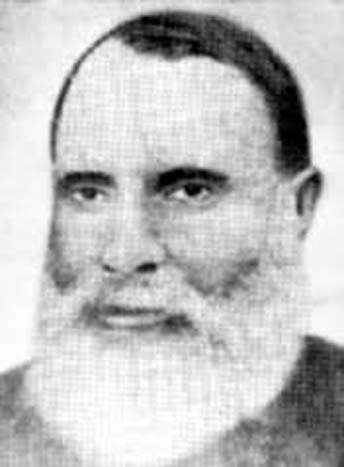
Bimal Guha :
Mir Mosharraf Hosain (1847-1912) novelist, playwright and essayist, born at Lahinipara in the district of Kushtia on 13 November 1847, was the son of Mir Moazzem Hosain, a zamindar. Mosharraf Hosain learned Arabic and Persian with a teacher at home and then Bangla at a pathshala. He began his formal education at Kushtia School and then studied up to Class V at Krishnanagar Collegiate School. He was admitted to Kalighat School in Kolkata but could not complete his studies. Mosharraf Hosain began his career looking after his father’s landed property. Later he served the Faridpur Nawab Estate and, in 1885, the Delduar Estate. He lived in Kolkata from 1903 to 1909.
While still a student, Mosharraf Hosain worked as a Mofussil Reporter for the Sangbad Prabhakar (1831) and Grambarta Prakashika (1863). His literary career also started here. Kangal Harinath, editor of Grambarta Prakashika, was his literary guru. Mosharraf Hosain later worked as editor of the Azizannehar (1874) and Hitokori (1890). He was also associated with the Vangiya Sahitya Prishad.
Mosharraf Hosain was a pioneer among nineteenth-century Bengali Muslim writers. His first novel, Ratnabati, was published in 1869. Apart from novels, Mosharraf Hosain wrote poetry, plays, textbooks and an autobiography. Among his works are Gauri-Setu (1873), Basantakumari Natok (1873), Zamindar Dorpon (1873), Er Upay Ki (1875), Bihad Sindhu (1885-1891), Songit Lahari (1887) Go-Jibon (1889), Behula Gitabhinoy (1889), Udasin Pothiker Moner Kotha (1890), Tahmina (1897), Tala Obhinoy (1897), Niyoti Ki Obonoti (1889), Gazi Miyar Bastani (1899), Maulood Sharif (1903), Musalmander Bangala Shiksha (2 parts, 1903, 1908), Bibi Khodejar Bibaho (1905), Hazrat Umorer Dhormojiban Labh (1905), Madinar Gaurab (1906), Bajimat (1908), Amar Jiboni (1908-1910), Amar Jibonir Jiboni Bibi Kulsum (1910) etc.
Bishad Sindhu, which narrates the tragic tale of the battle of Karbala, is considered to be his masterpiece. Zamindar Dorpon was written against the background of the peasant riots in Sirajganj during 1872-73. In much of his writing, Mosharraf Hossain satirised the follies and vices of contemporary society. In Gazi Miyar Bostani, for example, he criticised the chaos and corruption of nineteenth-century Bengal in general and the increasing freedom of women in particular, which he believed led to loose living.
Mosharraf Hossain was outspoken and free from communal prejudices. He did not hesitate to take up positions that would make him unpopular among his own community. He believed that the indiscriminate slaughtering of cows would endanger agriculture and accordingly, wrote the essay ‘Gokul Nirmul Ashooka’, against this practice.
He died in 1912 and was buried at Padamdi.
-Banglapedia
Mir Mosharraf Hosain (1847-1912) novelist, playwright and essayist, born at Lahinipara in the district of Kushtia on 13 November 1847, was the son of Mir Moazzem Hosain, a zamindar. Mosharraf Hosain learned Arabic and Persian with a teacher at home and then Bangla at a pathshala. He began his formal education at Kushtia School and then studied up to Class V at Krishnanagar Collegiate School. He was admitted to Kalighat School in Kolkata but could not complete his studies. Mosharraf Hosain began his career looking after his father’s landed property. Later he served the Faridpur Nawab Estate and, in 1885, the Delduar Estate. He lived in Kolkata from 1903 to 1909.
While still a student, Mosharraf Hosain worked as a Mofussil Reporter for the Sangbad Prabhakar (1831) and Grambarta Prakashika (1863). His literary career also started here. Kangal Harinath, editor of Grambarta Prakashika, was his literary guru. Mosharraf Hosain later worked as editor of the Azizannehar (1874) and Hitokori (1890). He was also associated with the Vangiya Sahitya Prishad.
Mosharraf Hosain was a pioneer among nineteenth-century Bengali Muslim writers. His first novel, Ratnabati, was published in 1869. Apart from novels, Mosharraf Hosain wrote poetry, plays, textbooks and an autobiography. Among his works are Gauri-Setu (1873), Basantakumari Natok (1873), Zamindar Dorpon (1873), Er Upay Ki (1875), Bihad Sindhu (1885-1891), Songit Lahari (1887) Go-Jibon (1889), Behula Gitabhinoy (1889), Udasin Pothiker Moner Kotha (1890), Tahmina (1897), Tala Obhinoy (1897), Niyoti Ki Obonoti (1889), Gazi Miyar Bastani (1899), Maulood Sharif (1903), Musalmander Bangala Shiksha (2 parts, 1903, 1908), Bibi Khodejar Bibaho (1905), Hazrat Umorer Dhormojiban Labh (1905), Madinar Gaurab (1906), Bajimat (1908), Amar Jiboni (1908-1910), Amar Jibonir Jiboni Bibi Kulsum (1910) etc.
Bishad Sindhu, which narrates the tragic tale of the battle of Karbala, is considered to be his masterpiece. Zamindar Dorpon was written against the background of the peasant riots in Sirajganj during 1872-73. In much of his writing, Mosharraf Hossain satirised the follies and vices of contemporary society. In Gazi Miyar Bostani, for example, he criticised the chaos and corruption of nineteenth-century Bengal in general and the increasing freedom of women in particular, which he believed led to loose living.
Mosharraf Hossain was outspoken and free from communal prejudices. He did not hesitate to take up positions that would make him unpopular among his own community. He believed that the indiscriminate slaughtering of cows would endanger agriculture and accordingly, wrote the essay ‘Gokul Nirmul Ashooka’, against this practice.
He died in 1912 and was buried at Padamdi.
-Banglapedia

